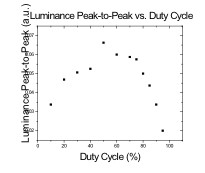
Research Archives index
Lifetime Issues for Organic Polymer Light-Emitting Devices: Pulsed Driving Schemes
Aaron R. Johnson and Jerzy Kanicki
 Increasing the lifetime of organic polymer light-emitting devices (PLEDs) is a major obstacle for the widespread adoption by industry of this technology. Many avenues of research have approached this problem, concentrating on both intrinsic factors such as chemical stability, and extrinsic factors, such as oxygen and moisture diffusion. One avenue is to tailor the excitation of the PLED device with a pulsed source so to maximize the light output, while extending the life of the device. Increasing the lifetime of organic polymer light-emitting devices (PLEDs) is a major obstacle for the widespread adoption by industry of this technology. Many avenues of research have approached this problem, concentrating on both intrinsic factors such as chemical stability, and extrinsic factors, such as oxygen and moisture diffusion. One avenue is to tailor the excitation of the PLED device with a pulsed source so to maximize the light output, while extending the life of the device.
This project seeks to explore the effects of pulsed driving schemes on the operating properties of PLED devices fabricated at the Organic and Molecular Electronics Lab (OMEL). Such properties include luminance, efficiency, color, rise and fall times and, of course, lifetime. We seek to understand, in both a qualitative and practical sense, the effect of duty cycle, period and waveform on the abovementioned aspects of PLED operation and to find the proper trade-offs to optimize the PLED performance.
  We have already seen that the rise and fall time of the luminance is dependent on the signal amplitude as well as the applied duty cycle. This, combined with an observed dependence of the OLED luminance on the pulse amplitude, imply that an optimal set of source conditions can be found which maximizes the light output while minimizing the extrinsic effect of device degradation. We have already seen that the rise and fall time of the luminance is dependent on the signal amplitude as well as the applied duty cycle. This, combined with an observed dependence of the OLED luminance on the pulse amplitude, imply that an optimal set of source conditions can be found which maximizes the light output while minimizing the extrinsic effect of device degradation.
Principal among the extrinsic degradation factors is joule heating of the device through electrical stimulation. Such a degrading effect, then, can be mitigated via the proper choice of pulse duty cycle. We have already observed that duty cycle is a critical parameter when optimizing the sourcing of OLEDs
These studies will be useful in the design of active-matrix organic light-emitting displays (AM-OLEDs), where the temporal effects of PLEDs will have a large influence on the performance of the display device.
top
|

